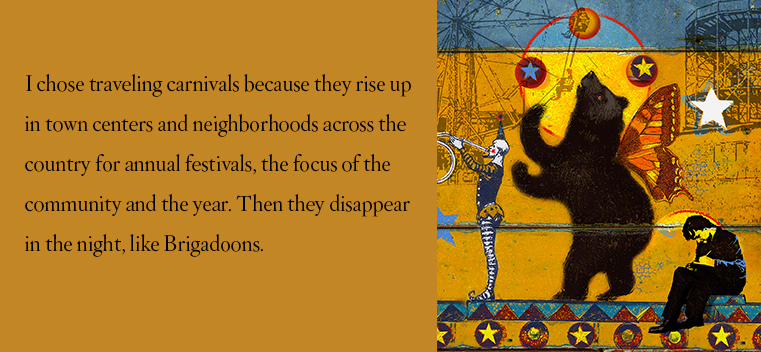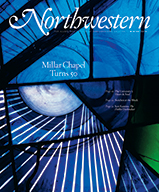
Life Is a Carnival
Michael Sean Comerford (GJ84), an award-winning Chicago-based journalist, lives out of his backpack and wrote this essay from a McDonald’s near the State Fair of Texas in Dallas.
Tell us what you think. E-mail comments or questions to the editors at letters@northwestern.edu.
Ever wonder about those strange designations we use throughout Northwestern to identify alumni of the various schools of the University? See the complete list.
Find Us on Social Media
Writer Michael Sean Comerford works as a carny for creative inspiration.
This week I slept in the same bed as my carnival boss, Chango, which is Spanish for “monkey,” a gang name, not a moniker his mother gave him.
His most remarkable feature is a bulbous belly with a knife-fight scar down the center that swirls like a question mark, with a belly button dot. He loves Tecate beer, Marlboro Reds and chocolate muffins. He is 35 and has been a carny for 17 years. His hair is short shaved, and he wears a more-clever-than-the-mark smile.
In our shared hotel room on our carnival route between the Minnesota and Oklahoma state fairs, he snored like a lion, and I slept the sleep of a hunter.
All year I’ve been sleeping, working and living shoulder to shoulder with this subculture of traveling carnivals from coast to coast in the United States. I’ve worked for six traveling carnivals in eight states and will work for more before ending the year, visiting a feeder town for migrant carnival workers in the Mexican state of Veracruz.
Living on carnival wages, I’ve hitchhiked 12,000 miles of the most stunning roads in North America — along the Alaska Highway, through Denali National Park and across the deserts of the American Southwest.
In traveling carnivals, the wildlife have names like Chunk of Cheese, Cotton Candy Cathy, Lurch, Porkchop, Darko, Shorty, Breeze, John Gotti, Ghost and Cockroach.
In California, in honor of St. Patrick’s Day, Mexican migrant carnies dubbed me “Póg mo thóin,” which is Gaelic for “kiss my ass.”
While hitchhiking, I’ve met drivers who included a Princeton butterfly lepidopterist, a California inventor, a magician, an author, bloggers, criminals, preachers, truckers and a man who said he found the secret of happiness in his yellow school bus in the shadow of a mountain named Pink.
I’ve taken videos of some of these people and written about them on my website, “Eyes Like Carnivals,” and the Huffington Post is running my blog.
The Internet brings immediacy to each story — it is happening as I write. I hope to write a book at the end of the year, adding the perspective of having lived the life.
That immediacy is something I didn’t have in my earlier travels when I wanted the open road as a teacher before writing seriously about lives and struggles for meaning.
A young man possessed, I hitchhiked across North America, Europe, the Middle East and North Africa. I could whip out a road story from the next bar stool but never sat down to pound out a book.
Then years went by, and the stories lost their touch of danger and thrill of the new. I embarked on this year for several reasons, not the least of which is that I want to change myself into a book writer. After spending all my professional life as a daily newspaper journalist, I decided to pull out all the stops and go on the road.
I chose traveling carnivals because they rise up in town centers and neighborhoods across the country for annual festivals, the focus of the community and the year.
Then they disappear in the night, like Brigadoons.
I ask deeply personal questions of carnies and drivers who pick up hitchhikers. I ask about childhood, family, work, money, travel, age, violence, love, sex and “America.”
When this year began, I had “the mother of all doubt” sitting on my shoulders. After all, I turned 54 years old while undertaking the hardest physical work of my life.
Some nights, I tore down carnivals from midnight until the next afternoon. After working a full day on rides, it was a weekly 30-hour work marathon.
I’ve stood on top of a carousel center pole on a greased up crank in a violent lightning storm. I’ve been moments away from fights with younger, stronger carnies. I’ve slept with armies of bedbugs and once woke to a herd of Black Angus cows staring in my open van window.
All for a job that pays $250 to $375 a week, sometimes for 80 to 100 hours of work. So I’ve also been broke, a near constant state for many carnies.
Lying next to Chango, I wondered what dreams these traveling people dream. I’ve read people have more than 100,000 dreams in their lifetime. Each day I listen and write what I hear, what I can intuit. I am here to witness, listening for the heartbeats and watching for the telling clues, like a question mark across a carny’s guts.



 Facebook
Facebook Twitter
Twitter Email
Email


